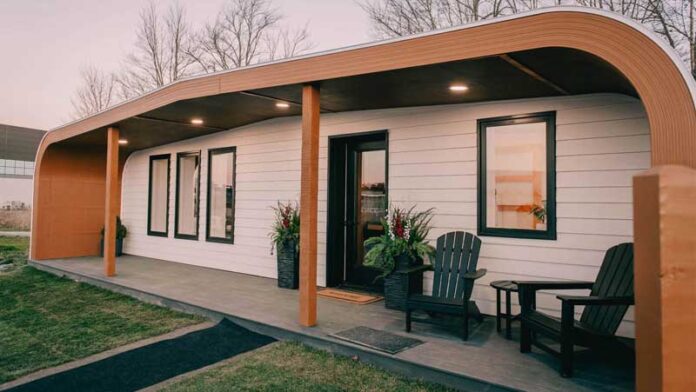The University of Maine has unveiled the world’s first 3D-printed home, made out of entirely recyclable materials. It’s called BioHome3D. With the use of wood waste from sawmills and “bio-resins,” the university was able to print the floors, walls, and ceiling. The house comes in pieces, ready to be put together with the doors, windows, and electrical wiring. Insulation is already built in. . BioHome3D was developed with funding from the U.S. Department of Energy’s Hub and Spoke program between the UMaine and Oak Ridge National Laboratory. Partners included MaineHousing and the Maine Technology Institute.
The 600-sq.-foot prototype options 3D-printed flooring, partitions and roof of wooden fibers and bio-resins. The home is absolutely recyclable and extremely insulated with 100% wooden insulation and customizable R-values. Construction waste was practically eradicated as a consequence of the precision of the printing course of.
“Our state is facing the perfect storm of a housing crisis and labor shortage, but the University of Maine is stepping up once again to show that we can address these serious challenges with trademark Maine ingenuity,” mentioned Gov. Janet Mills.
The U.S. and Maine, in particular, are experiencing a crisis-level shortage of affordable housing. The National Low Income Housing Coalition reports that nationally, there is a need for more than 7 million affordable housing units. In Maine alone, the deficit is 20,000 housing units and growing each year, according to the Maine Affordable Housing Coalition. Nearly 60% of low-income renters in Maine spend more than half of their income on housing. This untenable situation is exacerbated by the twin challenges of a labor shortage and supply chain-driven material price increases.
The center’s executive director, Habib Dagher, says this is a step forward in addressing the affordable housing crisis facing Maine and other areas of the country.
“It’s a lot of people working together towards a goal and a dream to provide housing to people that need it. There’s an incredible housing crisis, not only in Maine, but throughout the US, cut the cost too much, and we don’t have people to build them. So the other way to get there is to automate the process, that’s what we’re trying to do, and instead of using very expensive materials were using word residuals from the forest,” said Dagher.
This project is in partnership with the Maine Housing Authority and the U.S. Department of Energy and a program between UMaine and Oak Ridge National Laboratory.
With today’s production of the world’s first ever 3D-printed house made from recycled forest products, the University of Maine continues to demonstrate its global leadership in innovation and scientific research,” said Sen. Collins. “This remarkable accomplishment was made possible by the tenacity and expertise of Dr. Habib Dagher, his team and students at the UMaine Advanced Structures and Composites Center. I commend them on pioneering this new market opportunity for Maine’s forest products industry, which could help alleviate our nation’s housing shortage. Their groundbreaking work will lay the foundation for the future of affordable housing and help create new jobs across our state.”
The technology is designed to address labor shortages and supply chain issues that are driving high costs and constricting the supply of affordable housing. Less time is required on-site building and fitting up the home due to the use of automated manufacturing and off-site production. Printing using abundant, renewable, locally sourced wood fiber feedstock reduces dependence on a constrained supply chain. These materials support the revitalization of local forest product industries and are more resilient to global supply chain disruptions and labor shortages.
Using the superior manufacturing processes and supplies developed at UMaine, future low-revenue properties will be custom-made to satisfy a house owner’s house, vitality effectivity and aesthetic preferences. Importantly, as the manufacturing know-how and supplies manufacturing are scaled up, homebuyers can count on sooner supply schedules.
“We are finding solutions here at ASCC to the pressing problems that our world faces and that Maine faces, through research on transformative offshore wind technology, next-generation solutions for transportation infrastructure, advanced forest products and large-scale 3D printing, and of course, affordable housing,” mentioned UMaine President Joan Ferrini-Mundy. “The work that goes on in this lab absolutely exemplifies the work of a land grant institution — an institution that was started in order to help to solve the problems of, and further the economic advancement of, the state of Maine in partnership with the people of Maine. As an institution, I couldn’t be more proud to point to this lab and exactly how that’s happening right here.”
The prototype is at present sited on a basis exterior ASCC, outfitted with sensors for thermal, environmental and structural monitoring to check how BioHome3D performs by means of a Maine winter. Researchers count on to make use of the information collected to enhance future designs.
This project is the product of strong partnerships in and beyond the UMaine community. The DOE-funded Hub and Spoke Program between UMaine and Oak Ridge National Laboratory is leading the research and development of sustainable, cost-effective bio-based 3D printing feedstock alternatives, such as the material used for BioHome3D. The Hub and Spoke program is a direct result of a request initiated in 2016 by Sens. Collins and Angus King for a U.S. Department of Commerce Economic Development Assessment team to help Maine bolster the forest economy and create jobs and opportunity in rural regions of the state following the closure of several large paper mills.
“This project gives us a real possibility to achieve something that has eluded us to-date, and that is the speed of production, to be able to mass produce in a very fast way housing. The idea that we can create housing units in a fraction of the time with a fraction of the workforce – that is an efficiency that we’ve never experienced before. It’s going to stretch our precious state and federal resources exponentially, and most importantly, provide – quickly – for those most in need in our state,” said Daniel Brennan, director of MaineHousing.

